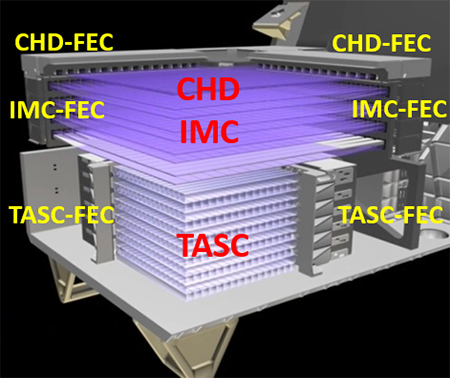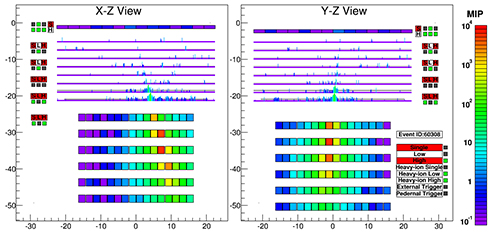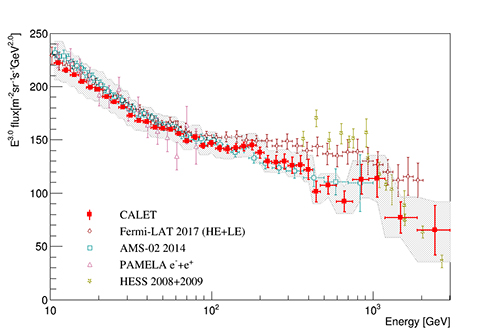This is an archive of information released in the past.
Disclaimer: It may contain broken links or outdated information. Some parts may not function in current web browsers.
*Visit https://humans-in-space.jaxa.jp/en/ for the latest information.

Experiment
- News
- Kibo Utilization Strategy
- Kibo Utilization Plan
- List of JAXA's Utilization Themes
- Experiment Facilities
- Space Environment Utilization
- Archive
The First Detection in Space of 3 TeV Cosmic Ray Electrons in a High-Precision Measurement of the Electron Energy Spectrum by CALET on the International Space Station
Waseda University
The research group led by Prof. Shoji Torii, Principal Investigator of the CALET mission, including Research Scientist Dr. Yoichi Asaoka, The Japan Aerospace Exploration Agency (JAXA) and international collaborators from Italy and the United States successfully carried out the high-precision measurement of cosmic-ray electron spectrum well into the TeV region, up to 3 TeV, that has been historically difficult to achieve with a direct measurement experiment, by using the CALorimetric Electron Telescope (CALET) on the Japanese Experimental Module - Exposed Facility on the International Space Station (ISS).
CALET was installed on the Exposed Facility of the "Kibo" module on the ISS in August 2015 and has been accumulating scientific data since October 2015 with a goal of longer-term operation. CALET is the first Japanese-led space-based mission dedicated to cosmic ray observations.
The origin and acceleration of cosmic rays are still one of the cosmic mysteries, and cosmic-ray electrons are one of the most important targets of high-energy cosmic ray research. However, in order to observe high-energy electrons, it is required to have (1) high-precision energy measurement of each cosmic-ray particle, (2) sensitivity to detect the very rare electron flux, and (3) the capability to identify electrons buried under the over 1,000 times higher flux of cosmic-ray protons. Thus the measurement of electrons above 1 TeV has been a difficult goal to achieve. The calorimeter of CALET, with its unique and crucial capabilities, enables us to perform accurate measurement of cosmic-ray electrons into the TeV region thanks to the long-term exposure available on the ISS.
This measurement demonstrates the ability of CALET to do a precise direct measurement of electrons above 1 TeV that was difficult for past experiments. For 5 years of observations, CALET will achieve nearly 6 times higher statistics compared to this first result, and will allow for reduction of the systematic uncertainties, including that from the detector response. Our goal is to push up the energy limit to 20 TeV and to obtain the precise energy spectrum, which has a high probability to discover nearby astrophysical cosmic-ray sources and/or to reveal the nature of dark matter.
The CALET electron spectrum result is to be published in "Physical Review Letters" on November 1, 2017.
【Contact details】
For Contents:
Faculty of Science and Engineering, Waseda University
Professor Shoji Torii, Research Scientist Yoichi Asaoka
Tel: +81-3-5286-3090
E-mail: torii.shoji@waseda.jp , yoichi.asaoka@aoni.waseda.jp
For ISS/Kibo:
Public Affairs Department
Japan Aerospace Exploration Agency (JAXA)
Tel: +81-50-3362-4374, Fax: +81-3-3258-5051
【Digest of science results】
(1) What we have known from previous studies (Scientific background)
In the new millennium, cosmic-ray observations in space get well underway. PAMELA, which has a small spectrometer but powerful capabilities for particle identification and discrimination of positive/negative charge of incident particles, takes the initiative in these observation, AMS-02 with more powerful and larger spectrometer has been observing cosmic-rays on the ISS. Fermi, whose main target is gamma rays, also embarked on the observation of charged cosmic-ray particles with a large-area calorimeter.
One of the most important results is the "excess of positrons" discovered by PAMELA and confirmed by AMS-02 with high precision. Contrary to the expectations of standard acceleration and propagation models, the positron ratio to electron increases at higher energy. This result implies the existence of new, unexpected positron source(s). Based on these results, more than 1,000 papers were published to discuss the origin of the positron excess by annihilation and/or decay of the dark matter and/or electron-positron pair creation and acceleration in astrophysical accelerators, such as pulsars.
(2) What is elucidated by this research
Cosmic-ray electrons above 1 TeV can only reach the Earth from nearby sources, such as young supernovae explosion remnants. Since there are only three candidates of these astrophysical objects, the precise measurements of electrons allow us to identify the astrophysical source originating these particles. The CALET measurement is the first time that this has been done using direct cosmic-ray observation. This result requires (1) high-precision energy measurements of the cosmic-ray particles, (2) sensitivity to detect the rare electron flux, (3) and the capability of accurate electron identification from the more than 1,000 times higher flux of protons in the TeV energy region. The primary goal of CALET is to investigate the nearby cosmic ray electron sources by developing and using this new instrument that satisfied the above requirements and carrying out a long-term observation in space.
The key issue to investigate "positron excess" is to observe the structure in the energy spectrum at highest energy region, because features in the spectrum will allow the origin to be determined, such as dark matter and/or pulsars. Since it is considered more natural that electron-positron pair creation occurs at the primary positron sources, the all-electron spectrum CALET observed is expected to feature a structure derived from the primary positron origin. For instance, the acceleration energy limit of pulsar or the mass of dark matter may be found in the spectrum at higher energy region. High-precision measurement of high-energy electrons (electrons + positrons: all-electrons) plays a key role to investigate the origin of "positron excess" as well.
(3) Newly developed methods
The CALET instrument was installed on the International Space Station in August 2015 and started science observations in October 2015. This is the first cosmic-ray observatory as a Japanese-led space experiment, with planned operation for 2 to 5 years. The CALET detector is optimized to observe high-energy electrons. The instrument has a calorimeter that consists of three components as shown in Fig. 1.

Figure 1: A schematic view of a calorimeter of CALET which consists of Charge Detector (CHD), Imaging Calorimeter (IMC) and Total Absorption Calorimeter (TASC) (Credit: JAXA/Waseda University)
The top part (CHD) of the detector identifies the charge of incident particles. The middle part (IMC) detects the incident direction. The bottom, thick part (TASC) measures the particle energy and identifies the species by detecting the particle cascade (shower) development. The combination of these characteristics allows us to obtain the most information of the incident particles. The most unique feature of the CALET detector is the thickness of TASC, because the highest energy that can be measured is limited by the thickness of the calorimeter. Figure 2 shows a candidate of 1 TeV electron. The particle impacted from the top of the detector and induced the shower cascade in the detector. Most of the energy is absorbed in the detector thanks to its deep thickness. These characteristics yield precise measurements with excellent energy resolution and powerful proton background rejection by analyzing the shower image profiles.
The availability of long-term observations on the ISS and the capabilities of the detector enable us to obtain the high-precision electron measurement in the TeV region. For 5 years of observation, analysis of the electron spectrum is expected to identify the nearby cosmic-ray sources and/or reveal the nature of dark matter.

Figure 2: Shower image of 1 TeV electron candidate which is visualized from flight data. (Credit: JAXA/Waseda University)
(4) Results and knowledge obtained from this study
Using the data obtained from October 13, 2015 to June 30, 2017, the all-electron (electron + positron) energy spectrum is shown as red points in Fig. 3. It shows that the energy spectrum up to 3 TeV has been directly measured for the first time in space. Systematic errors, which are the bias due to the imperfect modeling of the detector response, are shown as grey band. In order to understand the Universe, the study of the consistency of our experimental knowledge with theoretical models by using various observational data is mandatory. Therefore, the consistency between the observation results is also very important. Knowledge from our result is the following:
- The Energy spectrum below 1 TeV is very consistent with AMS-02 result within the measurement errors. This consistency obtained from different types of cosmic-ray measurements is the important evidence that the detector uncertainties are well understood.
- CALET has increased the energy limit of direct observation in space from 1 TeV to 3 TeV. In this energy region, it is expected that an observed energy cut-off would provide a measurement of the discrete electron+positron source distribution.
- Although it cannot be completely concluded at the moment because of the errors, including the systematic uncertainties, the spectrum implies there is a fine structure, not seen in the AMS-02 results. Because the mystery dwells in the details of the spectrum, further development of the analysis will help reduce the systematic errors and more event statistics will allow this energy region to be investigated in more detail.

Figure 3: Cosmic-ray all electron (electron+positron) spectrum measured by CALET in an energy range from 10 GeV to 3 TeV. Lateral axis shows the energy of the cosmic-ray electrons and positrons, vertical axis shows the flux multiplied the energy to the power of 3. Data from previous space experiments (Fermi-LAT, AMS-02 and PAMELA) and indirect measurements with a ground-based experiment (HESS) are also shown for comparison. (Credit: Waseda University)
(5) Broader impacts and social impact of research
The international scientific community has been keenly interested in CALET observations. Understanding the nature of dark matter, which is one of the most profound mysteries in the Universe, is one of the scientific objectives of CALET. An observation of a dark matter signal would be extremely newsworthy: not only to be reported in the news media but also be broadcasted on NHK BS and National Geographic. These will contribute to recognize not only the scientific results of CALET, but also the importance of Japanese Experimental Module on the International Space Station.
(6) Future plans
For the first result of CALET observation, only the events in a well-measured condition (i.e. the events that pass through the detector from the top to the bottom to maximize the detection capabilities and minimize systematic errors) were selected in the analysis. The statistics can be nearly 6 times larger by using all data after 5 years observation. Our goal is to push up the energy limit to 20 TeV and to obtain the precise cosmic-ray electron energy spectrum using a deeper understanding of the detector performance with the further analysis to reduce the systematic errors. The possibility of the discoveries is hidden in the details in the structure of the spectrum. The CALET observation may reveal the nature of nearby astrophysical sources and/or the nature of dark matter.
(7) Abstract (~100 characters) for spreading by SNS
The first detection in space of 3 TeV cosmic-ray electrons with high precision.
The measurement of electron energy spectrum by CALET on the International Space Station.
(8) Terminology
- cosmic-ray
- cosmic-ray acceleration
- spectrum
- cut-off
- electron volt
There are many particles in the radiation from outer space although we can't see them in our eyes. These are particles that are smaller than atoms such as the protons and tiny electrons. If you put your hand at the outer space, more than 100 of particles will hit on your hand in 1 second. We have called these particles cosmic-rays. Understanding the nature of cosmic rays is still one of the most cutting-edge themes in physics even after the 100 years since they were discovered. The study of many phenomena in cosmic rays have increased the knowledge of mankind, such as the discovery of the positron and the meson. Cosmic rays come from a variety of objects, the Sun, the Milky Way Galaxy (our Galaxy which contains the our solar system, including our Earth) and sources outside our Galaxy. The most energetic cosmic rays come from outside of our solar system in which we live.
One of the most compelling theories to explain where the high-energy cosmic-rays come from and how they have been accelerated is "supernova explosion". A supernova is the explosion of the massive stars occurred at the end of their life and radiate enormous amount of energy. We consider the particles accelerated by the explosion and reached to the earth is the source of high-energy cosmic-rays from our galaxy, however the detail mechanism of how to accelerate these particles are not yet well understood.
In this article, we have used the term of spectrum as an energy spectrum. We have called plots that have the energy on the horizontal axis and the flux on the vertical axis as energy spectrum. Also, when we have stated that there is a structure in the spectrum, it means that there is a deviation from the simple power-law structure in the spectrum.
If the energy spectrum rapidly decreased above a certain energy, we have called the energy as a cut-off energy.
A unit of energy. 1 eV is the amount of energy gained by the electron moving across voltage potential difference of 1 volt without any resistance. Here, we are concerned with energies from a GeV (109 eV) into the TeV (1012 eV) region.
(9) Information of the letter
- Journal title: Physical Review Letters 119, 181101 - Published November 1, 2017
- Letter title: Energy Spectrum of Cosmic-ray Electron and Positron from 10 GeV to 3 TeV Observed with the Calorimetric Electron Telescope on the International Space Station
- Authors: O. Adriani et al. (CALET Collaboration)
- Corresponding authors: S. Torii and Y. Asaoka
*All times are Japan Standard Time (JST)
| Copyright 2007 Japan Aerospace Exploration Agency | Site Policy |